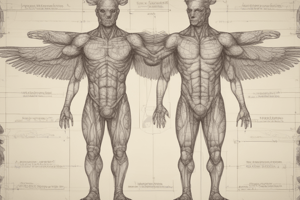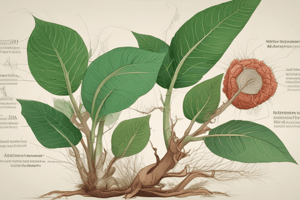Podcast
Questions and Answers
Which root system is characterized by numerous thin, hair-like roots that remain near the surface of the soil?
Which root system is characterized by numerous thin, hair-like roots that remain near the surface of the soil?
- Tuberous root
- Fibrous root (correct)
- Climbing root
- Taproot
What is the primary function of prop roots in plants?
What is the primary function of prop roots in plants?
- Absorption of moisture
- Photosynthesis
- Structural stability for the stem (correct)
- Storage of nutrients
Aerial roots are primarily used for what purpose?
Aerial roots are primarily used for what purpose?
- To anchor the plant into the ground
- To absorb moisture from the atmosphere (correct)
- To increase photosynthetic surface area
- For nutrient storage
Which of the following characteristics is true about fibrous roots compared to taproots?
Which of the following characteristics is true about fibrous roots compared to taproots?
The primary root of a plant that tends to be short-lived and is replaced by adventitious roots most commonly indicates what type of adaptation?
The primary root of a plant that tends to be short-lived and is replaced by adventitious roots most commonly indicates what type of adaptation?
Which type of root is primarily formed from nodes of a running stem and may have swollen structures for storage?
Which type of root is primarily formed from nodes of a running stem and may have swollen structures for storage?
Which type of epithelial tissue consists of a single layer of elongated cells?
Which type of epithelial tissue consists of a single layer of elongated cells?
What type of root system is typically associated with drought-resistant plants?
What type of root system is typically associated with drought-resistant plants?
Which statement regarding the survivability of root systems in drought conditions is correct?
Which statement regarding the survivability of root systems in drought conditions is correct?
What distinguishes dense connective tissue from loose connective tissue?
What distinguishes dense connective tissue from loose connective tissue?
Which of the following type of connective tissue is primarily responsible for storing fat?
Which of the following type of connective tissue is primarily responsible for storing fat?
What is the composition of the extracellular matrix in connective tissue?
What is the composition of the extracellular matrix in connective tissue?
Which characteristic best describes stratified epithelial tissue?
Which characteristic best describes stratified epithelial tissue?
How is pseudostratified epithelial tissue structurally different from stratified tissue?
How is pseudostratified epithelial tissue structurally different from stratified tissue?
Which type of connective tissue is often found beneath the skin and acts as a shock absorber and temperature regulator?
Which type of connective tissue is often found beneath the skin and acts as a shock absorber and temperature regulator?
What common function do all types of connective tissue serve?
What common function do all types of connective tissue serve?
What type of root is exemplified by Hedera and is primarily used for climbing?
What type of root is exemplified by Hedera and is primarily used for climbing?
Which of the following is NOT one of the four main types of tissues in animal bodies?
Which of the following is NOT one of the four main types of tissues in animal bodies?
Which type of epithelial tissue is characterized by multiple layers of cells that can change shape and is found in areas subject to stretching?
Which type of epithelial tissue is characterized by multiple layers of cells that can change shape and is found in areas subject to stretching?
What is the primary function of connective tissue in the body?
What is the primary function of connective tissue in the body?
Which type of muscle tissue is characterized by voluntary control and striations?
Which type of muscle tissue is characterized by voluntary control and striations?
Which component is primarily responsible for transmitting signals in nervous tissue?
Which component is primarily responsible for transmitting signals in nervous tissue?
Which type of epithelial tissue consists of a single layer of flat cells and is involved in passive transport processes like diffusion?
Which type of epithelial tissue consists of a single layer of flat cells and is involved in passive transport processes like diffusion?
Which type of connective tissue primarily stores fat and provides insulation to the body?
Which type of connective tissue primarily stores fat and provides insulation to the body?
Flashcards
What is tissue?
What is tissue?
Specialized cells that work together to perform a specific function. They also contain extracellular material.
Epithelial tissue
Epithelial tissue
A type of tissue that provides covering or lining for the body's surfaces.
Connective tissue
Connective tissue
A type of tissue that supports, links, and cushions other tissues in the body.
Muscular tissue
Muscular tissue
Signup and view all the flashcards
Nervous tissue
Nervous tissue
Signup and view all the flashcards
Simple squamous epithelium
Simple squamous epithelium
Signup and view all the flashcards
Simple columnar epithelium
Simple columnar epithelium
Signup and view all the flashcards
Stratified squamous epithelium
Stratified squamous epithelium
Signup and view all the flashcards
Taproot
Taproot
Signup and view all the flashcards
Adventitious Root
Adventitious Root
Signup and view all the flashcards
Prop Root
Prop Root
Signup and view all the flashcards
Aerial Root
Aerial Root
Signup and view all the flashcards
Tuberous Root
Tuberous Root
Signup and view all the flashcards
Fibrous Root System
Fibrous Root System
Signup and view all the flashcards
Climbing Root
Climbing Root
Signup and view all the flashcards
Tuberous Adventitious Root
Tuberous Adventitious Root
Signup and view all the flashcards
What are Epithelial Tissues?
What are Epithelial Tissues?
Signup and view all the flashcards
Simple Cuboidal Epithelium
Simple Cuboidal Epithelium
Signup and view all the flashcards
What are Connective Tissues?
What are Connective Tissues?
Signup and view all the flashcards
What is the origin of Connective Tissues?
What is the origin of Connective Tissues?
Signup and view all the flashcards
What makes up the extracellular matrix of Connective Tissues?
What makes up the extracellular matrix of Connective Tissues?
Signup and view all the flashcards
What is Loose Connective Tissue?
What is Loose Connective Tissue?
Signup and view all the flashcards
Study Notes
Plant Body Organization
- The plant body, typically, is organized into a root system and a shoot system, which include the stem and leaves.
- Roots are typically underground, anchoring the plant in the soil and absorbing water and nutrients.
- The root system can include a taproot or a fibrous root system.
- Taproots: A dominant, primary root from which lateral roots emerge, often found in dicot plants.
- Fibrous roots: Many thin roots emerge from the stem, often found in monocot plants.
Root System Functions
- Anchorage: Roots are vital for anchoring plants in the ground to prevent the plant from falling and withstanding wind and storms.
- Absorption of water and nutrients: The root absorbs water and essential mineral nutrients from the soil.
- Food storage: Some roots store food reserves, such as the sweet potato.
- Elevating the plant above the ground: The root system anchors the plant for the stem and leaves to reach the sunlight.
Specialized Root Systems (Modifications)
-
Storage Taproots: Some taproots are modified for food storage, such as those found in carrots and beets.
- Fusiform: A modified tap root, swollen in the middle and tapering towards the ends. (e.g., radish)
- Napiform: The base region of the root is swollen, forming a spherical shape which tapers towards the lower end like a tail. (e.g., turnip)
- Conical: A swollen base at the wider part and gradually tapers to a narrow point. (e.g., carrots)
-
Adventitious roots: These are roots that develop on parts of the plant other than the radicle.
- For support: Prop roots (e.g. maize, corn).
- For storage: Tuberous roots (e.g. sweet potato).
-
Aerial roots: Roots that develop above the ground.
- Climbing plants: Climbing roots help the plant to climb by penetrating the support surfaces and attaching. (e.g. Hedera species)
- Water absorption from air: Aerial roots absorb water from the air.
- Support/anchorage: Aerial roots are also used to hold on to the support. (e.g. vine plants)
-
Fibrous roots: These roots are thin, hair-like, and numerous.
Tissue Systems
- Epithelial tissue: Covers and lines body surfaces or cavities.
- Connective tissue: Supports, connects, and separates different tissues or organs.
- Muscular tissue: Enables movement.
- Nervous tissue: Receives and transmits stimuli.
Types of Tissues
- Epithelial Tissue: Further categorized based on number of cell layers (simple or stratified) and cell shape (squamous, cuboidal, columnar).
- Connective Tissue: Classified into loose, dense and specialized connective tissues (e.g., cartilage, bone, blood, adipose).
- Muscle Tissue: Skeletal (voluntary), smooth (involuntary), and cardiac (involuntary).
- Nervous Tissue: Composed of neurons (nerve cells) and neuroglia, facilitating communication within the body.
Studying That Suits You
Use AI to generate personalized quizzes and flashcards to suit your learning preferences.
Related Documents
Description
Explore the intricate organization of the plant body, focusing on the root and shoot systems. This quiz delves into the functions of roots, including anchorage, absorption, and food storage, as well as the differences between taproots and fibrous roots.




